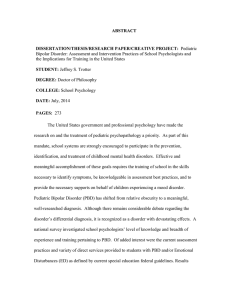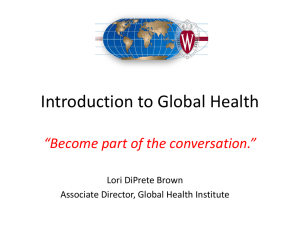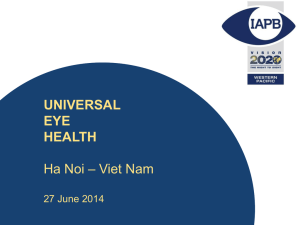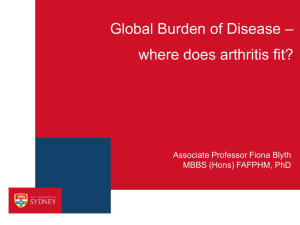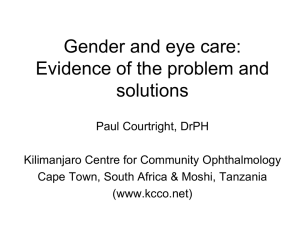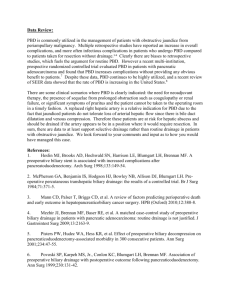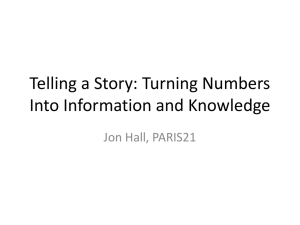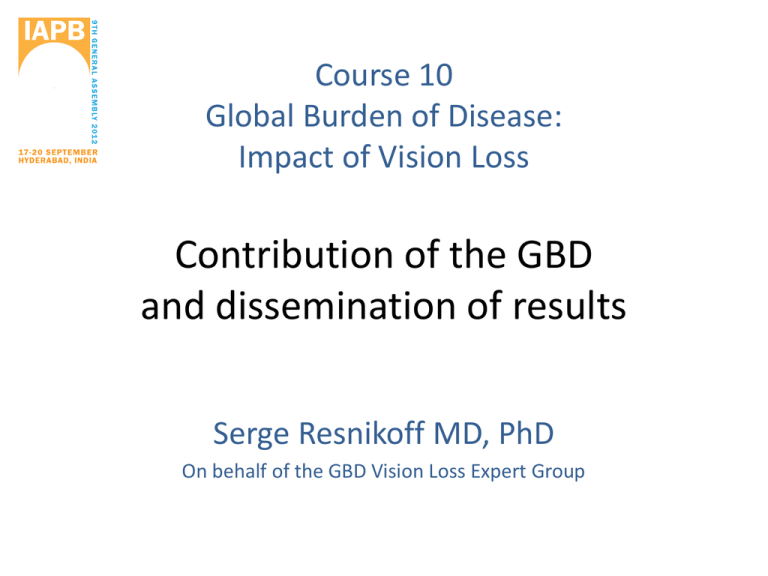
Welcome
Welcome
2
About IAPB & organising
partner L V Prasad Eye Institute
6
Course 10
Global Burden of Disease:
Impact of Vision Loss
Thanks to sponsors & supporters
Wednesday 19th
09:00 - 17:00
sday 18th
00 - 17:00
Thursday 20th
9:00 - 14:00
bal Sponsors and Supporters
over image: national bird of India
10
Guest & Keynote speakers
13
Eye health heroes
14
IAPB meetings
16
Programme at a glance
18
General information
21
Venue map
23
Exhibition map & exhibitors
24
Shuttle bus schedule
26
Contribution of the GBD
and dissemination of results
ational Sponsors and Supporters
onal Sponsors and Supporters
IAPB awards
Assembly information
Exhibition Times
nday 17th
00 - 17:00
9
Social programme
Welcome reception
29
Gala dinner
29
Vision for Everyone...Everywhere;
Launch Party
29
Dialogue in the dark
30
LVPEI’s Village Vision
Complex Tour
30
Programme: Days 1 - 4
Serge Resnikoff MD, PhD
DAY 1 - Monday 17th
33
DAY 2 - Tuesday 18th
55
3 - Wednesday 19th
71
OnDAY
behalf
of
the
GBD
Vision Loss Expert Group
DAY 4 - Thursday 20th
93
Satellite Programme
At a glance
102
Days 1 - 4
104
Exhibitors’ Profiles
113
Why do we need data?
• 1. To support Advocacy
“Advocacy is the process of influencing decisionmakers to create change”
• Requires best possible information for
– making effective policy decisions
– mobilizing more resources
Why do we need data?
• 2. To support priority setting, planning,
monitoring and evaluation
• Especially for quantifying how much needs to
be prevented and treated
• Implies:
– cause-specific data
– country level data
– periodically updated data
– comparable data over time for trends analysis
In the Past
• WHO/PBD Data Bank,
initiated by AD Negrel.
– Two closets in a
corridor
– Two papers published:
lists of publications
WHO/PBD Data Bank
In the Past
• WHO/PBD Data Bank, initiated by AD Negrel.
– Two closets in a corridor
– Two papers published: lists of publications
– 2006: attempt of integration in the WHO InfoBase
In the Past
• WHO/PBD Data Bank, initiated by AD Negrel.
– Two closets in a corridor
– Two papers published: lists of publications
– 2006: attempt of integration in the WHO InfoBase
• Used to generate periodic “global (and
regional) estimates of Blindness and Visual
impairment”
– 1970, 1976, 1990
– 1996, 2002, 2004, 2008, 2010
Contribution
• WHO Global Estimates
– initially used for the first GBD exercise
– then used to feed the WHO annual statistical
report (part of World Health Report) – till 2004
1996
1990 (WDR 1993)
VAD
Oncho
Trachoma
Sense Organ
Cataract
Glaucoma
WHR 2003
Glaucoma
Cataract
Vision loss, age related and other
W
Contribution
• WHO Global Estimates
– major role in the genesis of V2020 (avoidable
blindness, trends due to ageing, magnitude of URE)
– Mainly used for advocacy and communication
• Previous GBD data (1990/96, GBD 2004)
– Based on WHO/PBD estimates
– high impact on Cost Effectiveness analysis (cataract,
oncho, VAD…)
– major role in “ranking” VI against other conditions
(issue of groupings)
Top 10 Causes of Years Lived with Disability
Cataract
Vision disorders, Age-related
2
4
3
6
GBD 2001 (2006)
2
4
Cataract
Glaucoma
Trachoma
Onchocerciasis
Other
Second Edition (2006)
3.2% of total DALYs
Major issue: data are not directly comparable
Resnikoff & Keys, IJO 2012
How do the findings differ?
Blind
MSVI
40
300
35
250
30
200
25
20
150
15
100
10
50
5
0
0
1990
WHO/PBD
2010
GBD
1990
WHO/PBD
2010
GBD
Dissemination challenges:
What is needed?
• country level data (prevalence and causes) for
advocacy, priority setting, planning and
monitoring.
• data easy to understand and visualize
Visualisation
Dissemination challenges:
What is needed?
•
•
•
•
country level data (prevalence and causes)
data easy to understand and visualize
data easy to access and use (web based)
data regularly updated (as for mortality or
demographic data) – implies specific resources
and organization
Dissemination: Publication plan
• Published:
Editorial: Global Burden of Visual Impairment and Blindness.
Bourne R, Price H, Stevens G. Arch Ophthalmol. 2012;130(5):645647.
• Accepted for publication :
The Global Burden of Disease Project: Rationale and
Methodology of the Systematic Review by the Vision Loss Group.
Bourne R, Price H, Taylor H, Leasher J, Keeffe J, et al. Ophthalmic
Epidemiology. Accepted 1 Sept 2012.
• Submitted:
Global Prevalence of Vision Impairment and Blindness:
Magnitude and Temporal Trends, 1990-2010. Stevens G, White
R, Flaxman S, Price H et al. PLoS Medicine
Dissemination: Publication plan
• Planned:
– Cause specific data – at global level
– Regional papers combining causes with prevalence of
Vision Impairment and Blindness
• Also capstone papers from the GBD Core group on:
– Disability Weights
– DALYs.
Plan for the Future (5 years)
1.
2.
Maintain the global data base and provide periodic updates:
– Update the database by annual extensions of the systematic review
– Release an interim update in 2014/15.
– Revisit the statistical model and provide a 5 year update in 2017 .
Create an internet-based portal to:
– provide access to population-based prevalence data by age, by sex, by
region, by country, and by cause.
– model the data temporally, both retrospectively and prospectively.
– also provide additional parameters such as GDP and other metrics to
develop visualisations.
• Project is supported by BHVI

